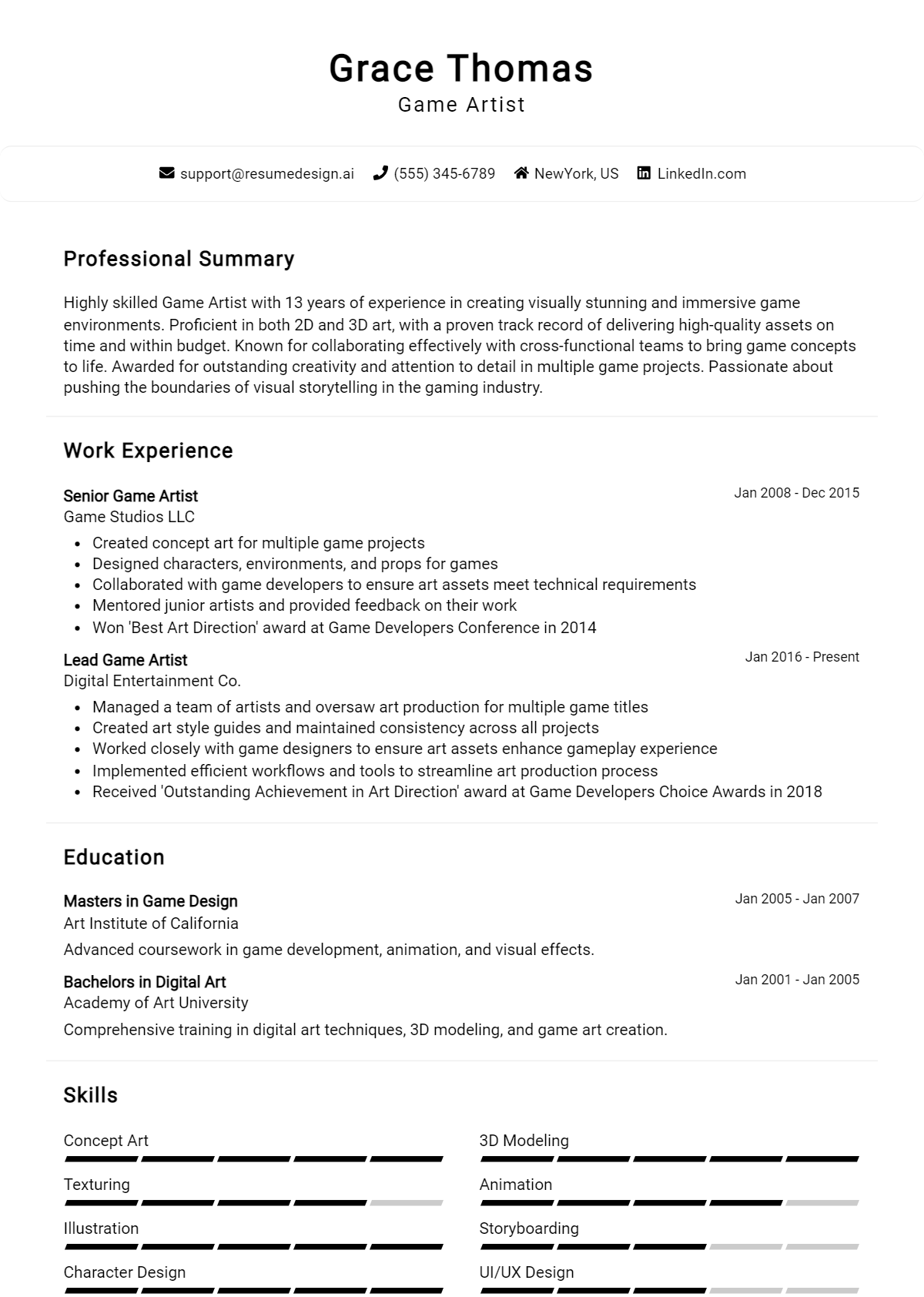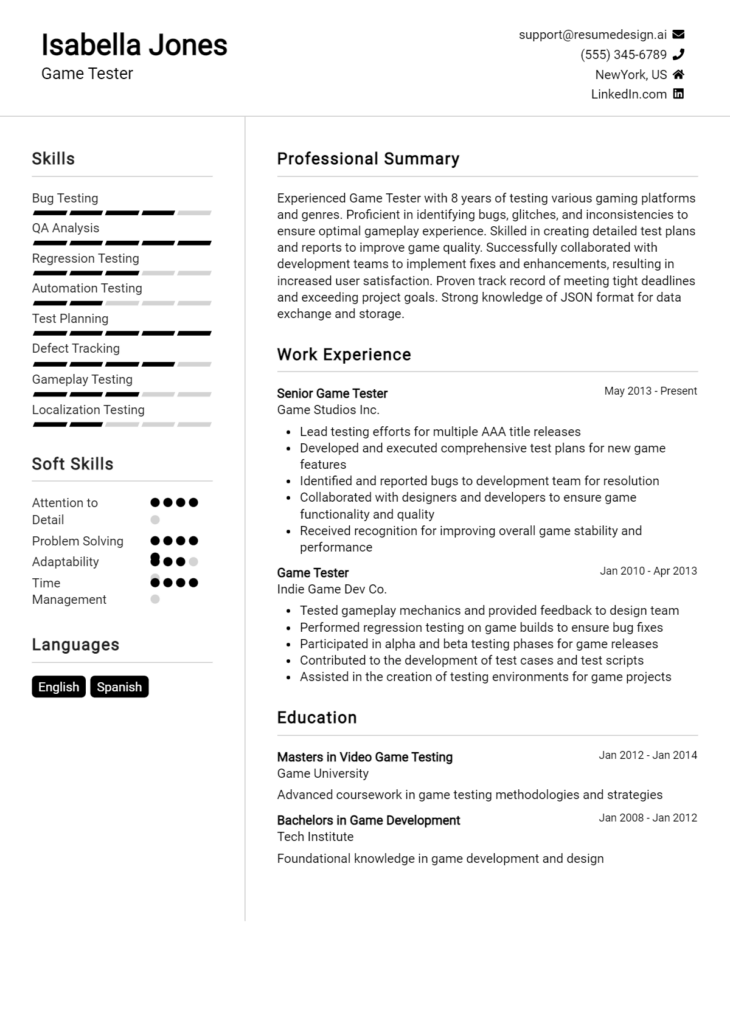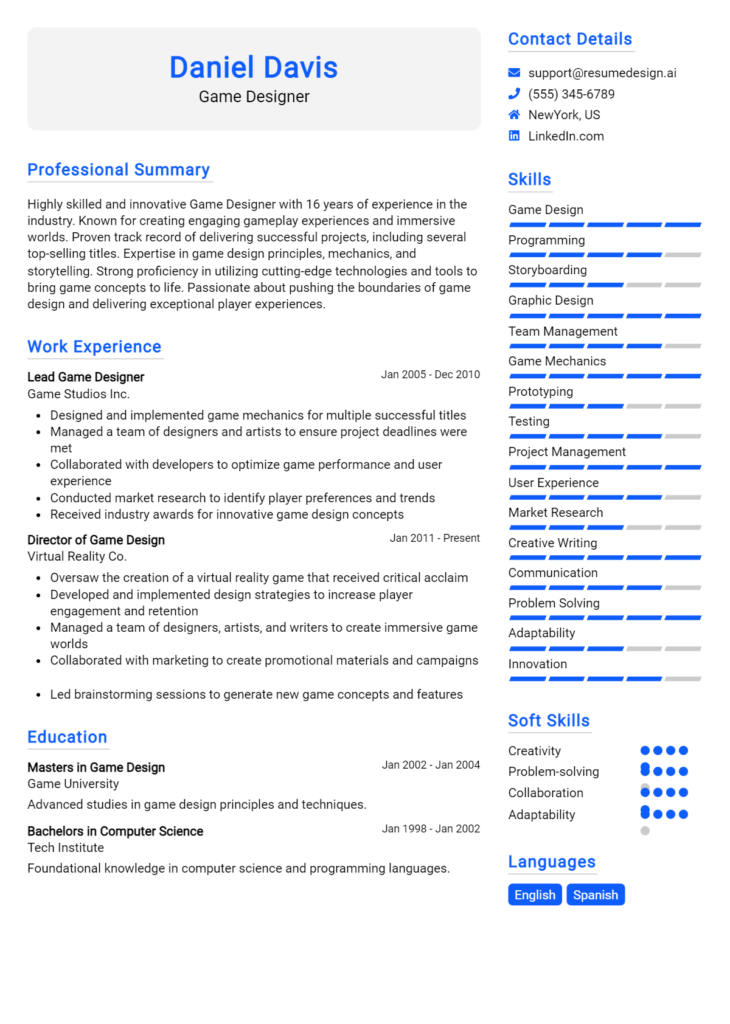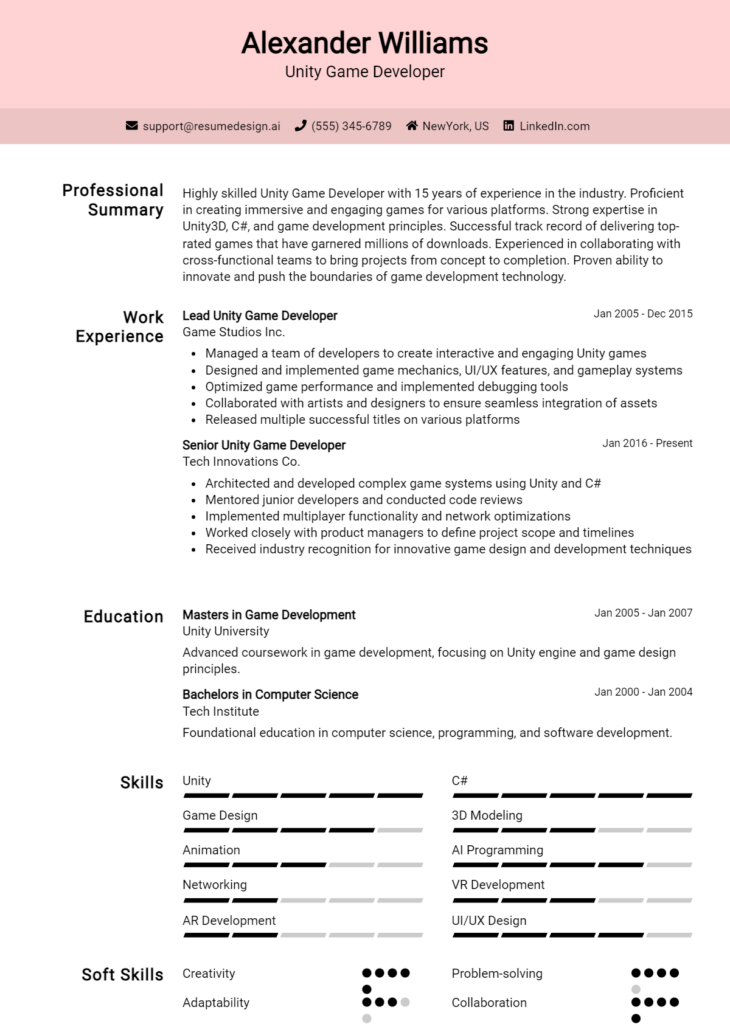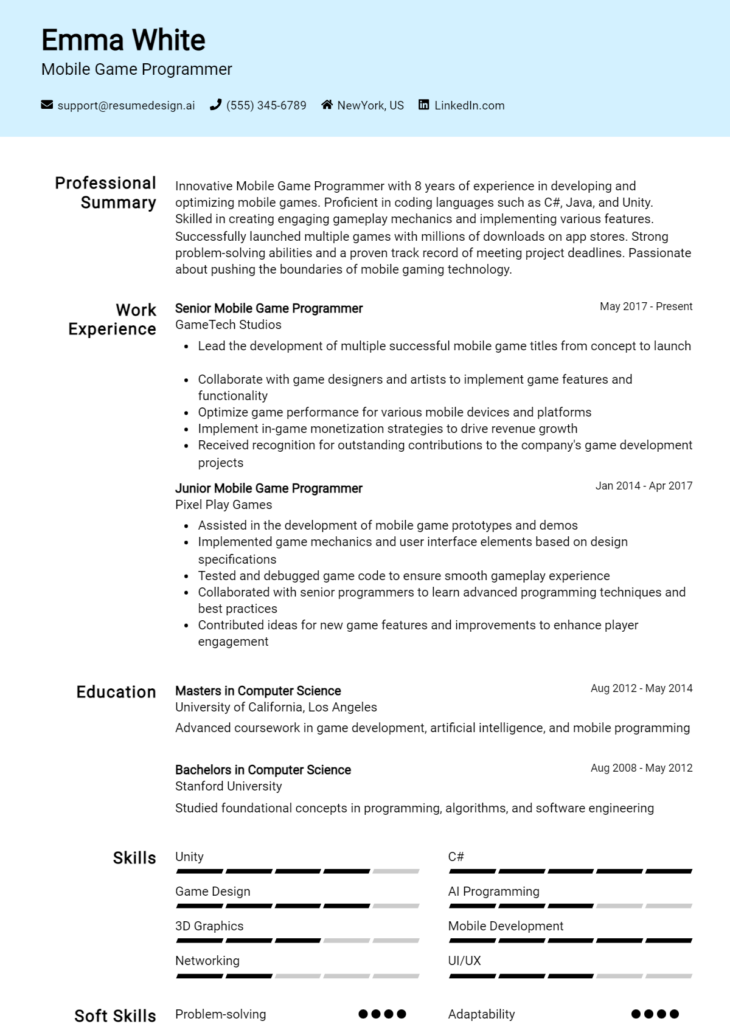Game Artist Core Responsibilities
A Game Artist plays a crucial role in the development of video games by creating visually stunning assets that enhance gameplay and storytelling. Key responsibilities include designing characters, environments, and visual effects while collaborating closely with game designers, programmers, and animators to ensure a cohesive artistic vision. Proficiency in software like Adobe Creative Suite and 3D modeling tools is essential, alongside strong problem-solving skills to address artistic challenges. A well-structured resume can effectively showcase these qualifications, highlighting the artist’s technical and operational capabilities that contribute to the organization’s creative goals.
Common Responsibilities Listed on Game Artist Resume
- Create character models, textures, and animations.
- Design environments and props to enhance gameplay.
- Collaborate with game designers to develop visual concepts.
- Produce high-quality 2D and 3D art assets.
- Implement art assets into game engines.
- Conduct visual research to inform design choices.
- Participate in art reviews and provide constructive feedback.
- Optimize assets for performance and memory efficiency.
- Keep up-to-date with industry trends and new technologies.
- Assist in creating marketing materials and promotional art.
- Work with sound designers to integrate audio and visuals.
- Participate in brainstorming sessions to generate innovative ideas.
High-Level Resume Tips for Game Artist Professionals
In the competitive world of game design, a well-crafted resume is more than just a document; it's your first introduction to potential employers and a crucial tool in showcasing your artistic talents and achievements. For Game Artist professionals, this means your resume must not only highlight your technical skills and creative capabilities but also reflect your unique contributions to past projects and teams. Given the visual nature of the industry, your resume should be as engaging as the games you create. This guide will provide practical and actionable resume tips specifically tailored for Game Artist professionals, ensuring that your resume stands out in a crowded job market.
Top Resume Tips for Game Artist Professionals
- Tailor your resume for each job application by closely aligning your skills and experience with the job description.
- Showcase relevant experience by including specific projects, roles, and responsibilities that highlight your artistic contributions.
- Quantify your achievements wherever possible, using numbers to illustrate your impact, such as project completion rates or user engagement metrics.
- Highlight industry-specific skills, including proficiency in software like Adobe Creative Suite, Blender, or Unity, and any specialized techniques you excel in.
- Incorporate a strong portfolio link that showcases your best work, ensuring it is easily accessible and visually appealing.
- Use clear, concise language and avoid jargon; focus on making your resume easy to read at a glance.
- Include keywords from the job listing to help your resume get past Applicant Tracking Systems (ATS) that many companies use.
- Demonstrate your passion for gaming and art by including personal projects or community contributions that reflect your interests.
- Keep your resume design clean and professional, considering the use of visuals to enhance presentation but avoiding clutter.
- Regularly update your resume to reflect new skills, experiences, and projects to keep it current and relevant.
By implementing these tips, you can significantly increase your chances of landing a job in the Game Artist field. A well-structured and focused resume will not only showcase your artistic talents but also demonstrate your commitment to the gaming industry, making a lasting impression on potential employers.
Why Resume Headlines & Titles are Important for Game Artist
In the competitive field of game design, a Game Artist's resume must stand out, and a well-crafted resume headline or title plays a crucial role in achieving that goal. A strong headline can immediately grab the attention of hiring managers, providing a succinct summary of a candidate's key qualifications and unique selling points in just a few words. It serves as the first impression, setting the tone for the entire resume. Therefore, the headline should be concise, relevant, and directly related to the specific job being applied for, encapsulating the artist's skills and experience in a way that resonates with potential employers.
Best Practices for Crafting Resume Headlines for Game Artist
- Keep it concise: Use 1-2 impactful phrases to convey your value.
- Be role-specific: Tailor the headline to the specific Game Artist position you are applying for.
- Highlight key skills: Incorporate relevant skills or technologies you excel in.
- Showcase experience: Include years of experience or notable projects that set you apart.
- Use action words: Start with strong verbs or adjectives that convey your abilities.
- Avoid jargon: Use clear language that is easy for hiring managers to understand.
- Make it relevant: Ensure the headline aligns with the job description and company values.
- Be creative: Use your artistic flair to create a memorable and engaging headline.
Example Resume Headlines for Game Artist
Strong Resume Headlines
Innovative 2D/3D Game Artist with 5+ Years of Experience in AAA Game Development
Passionate Concept Artist Specializing in Character Design and Visual Storytelling
Versatile Game Artist Proficient in Unity and Unreal Engine with a Focus on Immersive Environments
Weak Resume Headlines
Game Artist Looking for Opportunities
Creative Individual Seeking Job in Gaming
The strong headlines are effective because they clearly articulate the candidate's strengths and specific areas of expertise, making it easy for hiring managers to determine their fit for the role at a glance. They convey a sense of professionalism and confidence, while also being tailored to the job description. In contrast, the weak headlines fail to impress because they are vague and lack specificity, offering no insight into the candidate's skills or experience. This makes it difficult for employers to see the potential value the candidate could bring to their team.
Writing an Exceptional Game Artist Resume Summary
A well-crafted resume summary is essential for a Game Artist as it serves as the first impression for hiring managers. In an industry where creativity and technical skills are paramount, a strong summary can quickly capture attention by highlighting key skills, relevant experience, and notable accomplishments. This brief introduction should be concise yet impactful, tailored specifically to the job being applied for, ensuring that it resonates with the needs of the employer and sets the candidate apart from the competition.
Best Practices for Writing a Game Artist Resume Summary
- Quantify Achievements: Use numbers to illustrate the impact of your work, such as project completion rates or user engagement metrics.
- Focus on Key Skills: Highlight the most relevant skills for the position, including software proficiency and artistic techniques.
- Tailor the Summary: Customize the summary to align with the job description and requirements of the specific role you are applying for.
- Showcase Relevant Experience: Briefly mention significant projects or positions that directly relate to the desired job.
- Use Action Words: Start sentences with strong action verbs to convey energy and initiative.
- Keep it Concise: Aim for 2-3 sentences that clearly convey your value without overwhelming the reader.
- Highlight Awards or Recognition: If applicable, mention any accolades or recognition received in the field to bolster credibility.
- Maintain Professional Tone: Ensure the summary reflects professionalism while also showcasing your unique artistic flair.
Example Game Artist Resume Summaries
Strong Resume Summaries
Dynamic Game Artist with over 5 years of experience in 3D modeling and animation, contributing to AAA titles that achieved over 1 million copies sold. Proficient in Maya and ZBrush, recognized for creating immersive character designs that increased player engagement by 30%.
Creative Game Artist skilled in concept art and visual storytelling, with a track record of leading art teams on projects that garnered multiple awards. Successfully developed assets for mobile games that reached top 10 on app stores, enhancing user retention by 25%.
Innovative Game Artist with expertise in environmental art and texture design, having collaborated on projects that received high praise from critics. Delivered visually stunning landscapes that improved overall game ratings by 15%, utilizing tools like Substance Painter and Unity.
Weak Resume Summaries
I am a Game Artist with some experience in various projects and software.
A creative individual looking for opportunities in game design and art.
The examples of strong resume summaries are effective because they provide specific details about experiences, quantify achievements, and relate directly to the job role, making them appealing to hiring managers. In contrast, the weak summaries fail to offer concrete information, lack measurable outcomes, and appear generic, which diminishes their potential impact and does not effectively communicate the candidate's qualifications.
Work Experience Section for Game Artist Resume
The work experience section of a Game Artist resume is crucial as it serves as a testament to the candidate's technical skills and ability to deliver high-quality products within the gaming industry. This section not only showcases the individual's artistic capabilities but also highlights their experience in managing teams, collaborating with other departments, and adhering to industry standards. By quantifying achievements and aligning their experiences with industry requirements, candidates can effectively demonstrate their value to potential employers, making a compelling case for their hiring.
Best Practices for Game Artist Work Experience
- Highlight relevant technical skills such as 3D modeling, texturing, and animation.
- Quantify achievements with metrics, such as the number of assets created or projects completed on time.
- Showcase collaboration by detailing teamwork with designers, developers, and project managers.
- Include specific software proficiencies, like Maya, Unity, or Photoshop, relevant to the roles held.
- Emphasize leadership roles and responsibilities taken in previous positions.
- Use action verbs to convey impact and involvement in projects effectively.
- Align experiences with industry trends and demands to reflect current relevance.
- Keep descriptions concise but informative, focusing on the most significant achievements.
Example Work Experiences for Game Artist
Strong Experiences
- Led a team of 5 artists in the development of a AAA game title, resulting in a 25% increase in production efficiency and a successful launch.
- Created over 150 high-quality 3D assets for an indie game, contributing to a 4.8-star rating on Steam and over 10,000 sales within the first month.
- Implemented a new texturing workflow that reduced asset creation time by 30%, improving overall project timelines.
- Collaborated closely with the development team to design and integrate game environments, enhancing player immersion and engagement metrics by 15%.
Weak Experiences
- Worked on various projects as a game artist.
- Assisted in creating game graphics and assets.
- Participated in team meetings and discussions about game design.
- Helped with general art tasks in the studio.
The examples provided illustrate the distinction between strong and weak experiences. Strong experiences are characterized by quantifiable outcomes, clear demonstrations of leadership, and specific collaborations that showcase the candidate's impact on project success. In contrast, weak experiences lack detail and fail to convey the candidate's contributions or achievements, making them less compelling to potential employers.
Education and Certifications Section for Game Artist Resume
The education and certifications section is a crucial component of a Game Artist's resume, serving as a testament to the candidate's academic background and commitment to professional development. This section not only showcases relevant degrees and courses that align with industry standards but also highlights any certifications that demonstrate specialized skills and knowledge. By presenting details of relevant coursework, certifications, and ongoing training, candidates can significantly enhance their credibility, showcasing their dedication to continuous learning and their alignment with the specific requirements of the game art field.
Best Practices for Game Artist Education and Certifications
- Prioritize relevant degrees in art, design, or computer graphics.
- Include industry-recognized certifications such as those from Adobe, Autodesk, or Unity.
- Detail relevant coursework that pertains directly to game design, animation, or 3D modeling.
- Specify any specialized training programs or workshops attended.
- Highlight honors or awards received during academic studies.
- Keep the information concise and focused on the most impactful qualifications.
- Update the section regularly to reflect any new achievements or learning experiences.
- Consider the inclusion of online courses or bootcamps that are relevant to current industry trends.
Example Education and Certifications for Game Artist
Strong Examples
- Bachelor of Fine Arts in Game Design, University of California, 2021
- Certified Autodesk Maya Professional, 2022
- Advanced Game Art and Animation, Coursera (2023)
- Diploma in 3D Animation and Visual Effects, Vancouver Film School, 2020
Weak Examples
- Bachelor of Arts in History, University of Florida, 2019
- Certificate in Basic Computer Skills, Online Academy, 2020
- High School Diploma, Springfield High School, 2018
- Outdated Certification in 2D Animation (2005)
The examples listed as strong are considered relevant and current, showcasing educational achievements and certifications that directly relate to the skills needed in the game art industry. These qualifications demonstrate specialized knowledge and a commitment to the field. In contrast, the weak examples lack relevance to game artistry, either by focusing on unrelated fields or presenting outdated qualifications that do not reflect the evolving nature of the industry. Such distinctions highlight the importance of aligning educational credentials with job-specific requirements to enhance the candidate's appeal to potential employers.
Top Skills & Keywords for Game Artist Resume
As a Game Artist, showcasing your skills effectively in your resume is crucial to capturing the attention of potential employers. Your skills not only highlight your technical proficiency but also demonstrate your creative vision and ability to collaborate within a team. A well-structured resume featuring both hard and soft skills can set you apart in a competitive industry. Hiring managers often look for specific abilities that align with their project requirements, making it essential to tailor your resume with relevant skills that reflect your expertise and experiences. For a more comprehensive understanding of how to present your qualifications, you can explore resources on skills and work experience.
Top Hard & Soft Skills for Game Artist
Soft Skills
- Creativity
- Communication
- Teamwork
- Problem-solving
- Adaptability
- Time management
- Attention to detail
- Critical thinking
- Initiative
- Open-mindedness
Hard Skills
- Proficiency in software like Adobe Photoshop, Illustrator, and Blender
- 3D modeling and animation
- Texture mapping and UV mapping
- Understanding of game engines such as Unity or Unreal Engine
- Character design and concept art
- Knowledge of color theory and composition
- Rigging and skinning
- Visual storytelling
- Asset creation and optimization
- Familiarity with version control systems like Git
By focusing on these essential skills, you can build a standout resume that effectively communicates your capabilities as a Game Artist.
Stand Out with a Winning Game Artist Cover Letter
Dear [Hiring Manager's Name],
I am excited to apply for the Game Artist position at [Company Name] as advertised on [where you found the job listing]. With a strong background in digital art and a passion for creating immersive gaming experiences, I am eager to contribute my skills and creativity to your talented team. My proficiency in industry-standard tools such as Adobe Creative Suite, Blender, and Unity, along with my experience in character design, environments, and UI/UX, make me a strong candidate for this role.
Throughout my career, I have worked on various projects that have honed my ability to collaborate effectively with multidisciplinary teams, including game designers and programmers. During my time at [Previous Company Name], I was responsible for creating visually compelling assets for an award-winning mobile game that achieved over [number] downloads. My keen eye for detail and understanding of color theory allowed me to create engaging environments and character designs that resonated with players. I believe that my artistic vision, combined with my adaptability to feedback and iterative processes, will enable me to make a significant impact at [Company Name].
I am particularly drawn to [Company Name] because of your commitment to innovative gameplay and your focus on storytelling through art. I share your belief that visual elements play a crucial role in enhancing player experience, and I am eager to bring my unique perspective and artistic style to your upcoming projects. I am confident that my experience with both 2D and 3D art will allow me to contribute to the distinct visual narrative that [Company Name] is known for.
Thank you for considering my application. I look forward to the opportunity to discuss how my background and skills align with the goals of your team. I am excited about the possibility of contributing to [Company Name] and helping to create unforgettable gaming experiences.
Sincerely,
[Your Name]
[Your LinkedIn Profile or Portfolio Link]
[Your Contact Information]
Common Mistakes to Avoid in a Game Artist Resume
When crafting a resume as a Game Artist, it's essential to showcase both your artistic talents and your understanding of the gaming industry. However, many applicants fall into common traps that can undermine their chances of landing an interview. Avoiding these mistakes can help you present a more polished and professional image, allowing your skills and experiences to shine through. Here are some common pitfalls to steer clear of:
Lack of Tailoring: Failing to customize your resume for each job application can result in a generic impression. Tailor your portfolio and experiences to highlight the skills and projects that are most relevant to the specific game art position.
Overloading with Text: A cluttered resume filled with dense paragraphs can be overwhelming. Use concise bullet points to convey your experience and achievements clearly, making it easier for hiring managers to scan your resume.
Ignoring Technical Skills: Game art roles often require specific software proficiency. Neglecting to list relevant tools like Unity, Unreal Engine, or Adobe Creative Suite can signal a lack of technical knowledge.
Not Showcasing a Portfolio: A strong portfolio is crucial for any Game Artist. Omitting a link to your portfolio or failing to highlight your best works can hinder your chances, as visual examples are key in this field.
Weak Descriptions of Projects: Simply listing job titles without providing context can make your experience seem less impactful. Describe your contributions to projects, the techniques used, and the outcomes achieved to demonstrate your value.
Neglecting Soft Skills: While technical skills are important, soft skills like teamwork, communication, and problem-solving are equally vital in collaborative environments. Ensure you include these traits to present a well-rounded profile.
Ignoring Industry Trends: Failing to mention your awareness of current trends and technologies in game development can make you seem out of touch. Show that you understand the landscape by referencing relevant trends in your resume.
Poor Formatting: A resume that is hard to read due to inconsistent fonts, colors, or layout can detract from your professional image. Use a clean, organized format that enhances readability and allows your creativity to show without overwhelming the reader.
Conclusion
As we explored the essential skills and responsibilities of a Game Artist, it’s clear that creativity, technical proficiency, and a keen understanding of game design principles are paramount. A successful Game Artist not only brings characters and environments to life but also collaborates closely with game developers and other artists to ensure a cohesive vision. Mastering various software tools, staying updated with industry trends, and building a strong portfolio are crucial for standing out in this competitive field.
In conclusion, if you’re looking to advance your career as a Game Artist, it’s vital to have an impressive resume that accurately reflects your skills and experiences. Take a moment to review and refine your Game Artist Resume to showcase your best work and attract potential employers.
To assist you in this process, consider utilizing available resources such as resume templates, a resume builder, and resume examples that can provide inspiration and guidance. Additionally, don’t forget to craft a compelling cover letter using cover letter templates to further strengthen your application. Start enhancing your resume today and take the next step in your Game Artist career!

